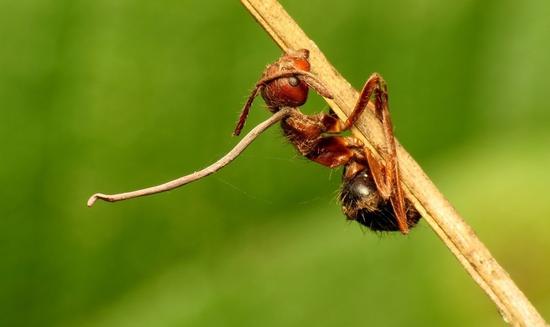The latest study by scientists found that zombie ant brains manipulated by Ophiocordyceps unilateralis were not attacked by fungi. The fungus can only reach its goal by manipulating the body of the ant. In other words, host ants are like drivers trapped in the driver’s seat while the fungi control the car’s wheels.
Finding the most evil case of mind control in the world is not difficult. You do not have to go to science fiction to go to a jungle like this tropical country like Brazil. Look closely at the leaves that are 25 centimeters from the forest floor and see if there is anything strange on the back. If you’re lucky, you may find an ant close to the leaf’s main veins, as if unable to fall off, and the jaws tightly clamping the leaves. But in fact, the life of this ant is over and its body belongs to Ophiocordyceps unilateralis, which is zombie fungus.

When the fungus infects the wood ant, it grows continuously in the ant and absorbs the nutrients in the ant and controls the consciousness of the ant. In a week’s time, the fungus forces the ants to leave their safe nest and climb to nearby plants. It will control the ants to stay in the 25 cm high, the location of the temperature and humidity are just right, conducive to fungal growth. In addition, the fungus also manipulates the ants to bite their jaws tightly to a leaf. Finally, the fungus grows a long stem from the ant’s head, forming a sporulated balloon. And ants tend to be manipulated to climb a leaf hanging over their habitual foraging path so fungal spores can fall onto other ants that pass through them and in turn erode them.
This fungus has an unrivaled skill in manipulating ants, the organism behind the monsters of the video game The Last of Us, or zombies in the movie The Girl with All the Gifts. This is also the obsession with Penn State entomologist David Hughes, who has been studying the fungus. He wondered how the fungus controls puppets – his latest experiment shows that the fungus is more cruel than thought.
Hughes’ Maridel Fredericksen used a special microscope to cut infected ants into 50-nanometer-thick slices, which are only about one-thousandth the thickness of the hair. She scans each piece carefully, compiles the images into three-dimensional models, and labels which tissues belong to the ants and which ones are fungi. It took Fredericksen just three months to tag a piece of a muscle alone. To speed things up, Hughes, in collaboration with computer scientist Danny Chen, used a kind of artificial intelligence to distinguish between ants and fungi.
Research shows that when a fungus first enters the host, it floats in the ants’ blood as a single cell, constantly self-replicating. But after some degree of replication, these single cells began to work together, as Fredericksen’s image shows. They connect to each other by establishing a short tube that is common to each other in plant-infected fungi. In this way, fungi can communicate with each other and exchange nutrition.
Leave a Reply